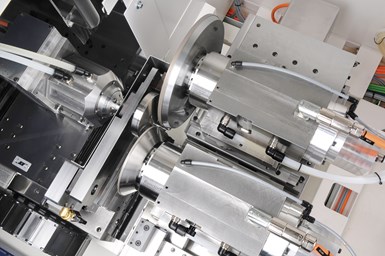Rollomatic Unveils Double Rough Pinch Grinding Process
Rollomatic has debuted its double rough pinch grinding process, which it says cuts cycle times and increases performance and thermal stability.
Share






ECi Software Solutions, Inc.
Featured Content
View More.png;maxWidth=45)
DMG MORI - Cincinnati
Featured Content
View More
Rollomatic, the original inventor of pinch and peel grinding, has developed a new “double rough pinch grinding” process to decrease cycle times for blank preparation of several carbide cutting tools.
Pinch grinding specializes in blank and tight surface finishes. The roughing and finishing wheels grind parts simultaneously, with the finishing wheel trailing the roughing wheel to perform both rough and finish grinding in one pass and reduce cycle times.
In double rough pinch grinding, users equip both grinding stations with diamond wheels with a grit size normally used for rough grinding. This leaves the blank “pinched” between two rough-grit diamond wheels, which then work simultaneously on the blank. While one wheel does the majority of the work, the second wheel cleans up what was left. This process further shortens the cycle times of the customary pinch grinding method.
Rollomatic recommends its new process when preparing T-slot cutters, thread end mills, end mills for die and mold machining, long-reach end mills and rotary burs. It also recommends the process for long-batch production.
Both grinding spindles are synchronous direct‐drive spindles with 19 hp peaks. The most important feature of a synchronous motor is that it provides constant speed during its operation with an efficient torque curve. Synchronous motors always run equal to their synchronous speed, as opposed to less-efficient asynchronous motors (induction motors) which always have a lag.
On a test production run of 100 pieces, the process achieved a cycle time (without loading or unloading) of 5 minutes and 5 seconds. Wheel spindle load never broke 35 percent, with wheel wear as the limiting factor rather than the machine. At a 35-percent power draw, the spindles did not release heat into the machine or grinding process – improving thermal stability. Rollomatic says the process outperformed alternative competitive equipment by 50 percent.
Related Content
-
The Future of High Feed Milling in Modern Manufacturing
Achieve higher metal removal rates and enhanced predictability with ISCAR’s advanced high-feed milling tools — optimized for today’s competitive global market.
-
High RPM Spindles: 5 Advantages for 5-axis CNC Machines
Explore five crucial ways equipping 5-axis CNC machines with Air Turbine Spindles® can achieve the speeds necessary to overcome manufacturing challenges.
-
How to Mitigate Chatter to Boost Machining Rates
There are usually better solutions to chatter than just reducing the feed rate. Through vibration analysis, the chatter problem can be solved, enabling much higher metal removal rates, better quality and longer tool life.






.png;maxWidth=150)

































